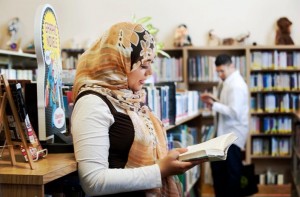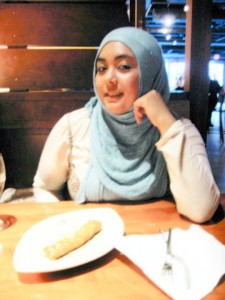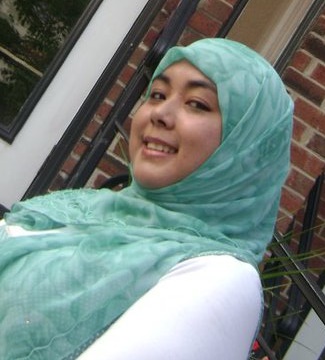I am a Muslim. I am an American. My father is Indonesian and my birth mother is Okinawan. I grew up in the Monterey Bay area in northern California. Growing up, I was never perceived as Asian. At one time, I chose “Pacific Islander” as my ethnicity, since my peers kept telling me that real Asians looked a certain way. That way didn’t look like me. Before I started wearing a headscarf, people assumed that I was Mexican. It was not an unfair assumption. The majority of the ethnic minorities in my primarily Caucasian town were Mexican or of Mexican descent. But it became rather tiresome to try to defend my inability to speak Spanish or know about my culture, when it really was just what others assumed as my culture. Not that I knew a ton about either of my inherited cultures in the first place. So, to add another layer to what I was supposed to know, a collective history of people over the last 1,400 years from different continents, cultures, languages, races – just because we shared a common religion – was just a little bit daunting.

A 2009 Gallup report found that the American Muslim community is the “most racially diverse religious group surveyed in the United States.” African Americans constitute 35 percent of this demographic and more than a quarter classify themselves as racially white, (yes, Virginia, a lot of Arabs check the white box), 20 percent are Asian, 18 percent identify as other, and 1 percent identify as Hispanic. So many Muslims have talked about our large “imagined community”[1] and what it means here in the United States. In this country, as in others, the Muslim community is a blend of Islamic ideas and identities. What it means to be Muslim is a conscious existential choice rather than a cultural given. It is a microcosm of the larger world and an amalgamation of identities, practices and norms that vie for a place of being authentic, Islamically and morally correct.
Since Islam is more of a blending of my cultural norm and ethnic identity, nationality took precedence in my identity, and I identified as just an American. I went to school, hung out with friends, did my homework and was involved in multiple extracurricular activities. It didn’t even occur to me that I was different from my friends, except that I knew I was Muslim, Indonesian and Japanese. I did have a teacher ask one time if English was my second language and a parent ask if anyone had ever discriminated against me because I wasn’t white. That was when the concept of identity really entered my consciousness. I asked my friends what they thought of me. They just said they saw me as me, and that meant more to me than anything else. It still does. The concept of a colorblind society was an idea that disturbed me, though, and I began to realize the privilege my peers had and what my own privilege had been.
Then 9/11 happened. I can honestly say that before then, I never thought I would wear a scarf. I was deeply interested in my faith, but it was much more in the context of history and spirituality rather than in actual practice. Until I went to college and met other Muslims, I only knew some of the social and religious normatives in the “mainstream” Muslim community. As I grew in my faith, I adopted more of these social mores, and my identity became more complex. When I put on my scarf, I automatically became an Arab. People assumed that I knew Arabic, that I didn’t know English, and that some man in my family was oppressing me, forcing me to veil myself.
Even my own family’s perception of me changed. One of my uncles was worried that I was never going to have fun again. My identity became faith first, then ethnicity and nationality. Yet, I was a minority within a minority, as most of the students in my Muslim Students’ Association were Pakistani and Arab. Strangely, though I was already supposed know everything about my collective Islamic history, my parents resented my adopting more Arab dress. I thought it was fine if I was wearing clothing from everywhere and everyone, but Indonesia wasn’t very well represented in Islamic fashion, at least in the States. And though this has changed in recent years, I found that unless they had been to the archipelago, other Muslims did not know much about Indonesia, other than that it is the most populous Muslim country in the world. It is a strange thing to think, in a community that is so large and diverse, it is almost an accepted norm to know each other by stereotypes.
I was lucky enough to have the opportunity to study abroad in Turkey in 2003. Like most study-abroad experiences, it was enlightening in so many ways, both frustrating and rewarding. What I found amusing, though, was the perception of Muslim Americans by the Turkish students I met. I had a conversation with a slightly inebriated young man who had watched “Malcolm X” and thought all Muslims in America were black. I thought it was funny when one of the Turkish girls on my floor said that they loved the slight chink in my eyes and declared me to be Asian, not questionably Asian. I was also able to travel a bit, visit other countries in the region. My overall takeaway from that experience was realizing just how American I am, despite, or perhaps because of, my multi-layered identity. Upon returning to the U.S., I felt like my identity had fractured even more.
When I was young, my cousin’s cousin came over from Indonesia to visit one summer. Upon meeting me, then a teenager, he declared me to be hancur. Hancur is an Indonesia word and has an array of meanings. In this particular context, it was used to describe something broken. It was not a nice thing to say. People with multiple backgrounds can have a view that might even be described as multi-faceted — layering mixed cultures, American identity, religion outside of the status quo and the perception of others. Such a viewpoint can lead to confusion, despair and the idea that one is never enough. I felt this way particularly during graduate school, despite my attending a program that had a cohort that was substantially diverse and in a very multicultural city. Graduate school can be an isolating experience for everyone, but I felt almost unwelcome, though I received my MLIS at my undergraduate alma mater. Little incidents, like hearing someone say there was too much of a focus on diversity in our program, having books knocked out of my hands as someone brushed past me, or facing glares in class from those that perceived me to be strongly prejudiced against the LGBT community, were flooring. The latter particularly disturbed me, as a relative had just come out to our family and I was helping my friend, a trans-man, acclimate to the area and to his physically expressed, postoperative identity.

Added to that was a proposed panel program at an annual professional librarian conference, in which a known critic of Islam was invited to speak. This panel was intended for an audience of ethnic and multicultural librarians as a representation of my community. By extension, it was meant to represent me. Though the panel program ended up being cancelled, I felt even more unwelcome in the library field.
Graduate school allows a student to develop skills and explore professional opportunities, but I found myself paralyzed into inaction. I entered the library field because of my interest and belief in the power of libraries. I wanted to provide information and dispel misinformation, not only in general, but specifically false impressions about any of my communities. I thought that it would be empowering for the public to see a person who looks like me working at the local level and to see that I was a normal person. I do regret not being more active, or more willing to advocate for myself during my graduate school years, but I was unwilling to share so much of myself with people whom I thought would not accept me even if I tried. It was much later though, with the help and support of a few good friends, and the recommendation of a professor to join APALA, that I was able to find my feet and my voice again.
There are problems that I face everyday, or at least on a regular basis. I have had patrons leave me proselytizing material, had a child ask if I was going to blow up the building, and have even received an anonymous death threat while on the job. I have been called “that Korean lady,” “that White lady” and, my favorite, “the lady with the rag on her head.” Like all of us in the public eye, I have had my share of negative experiences and I am sure there will be more over the course of my career. Working as a children’s librarian has also given me some of the most rewarding experiences of my life.
Finding support from other professionals in the field who have had similar experiences helped me to move beyond those negative experiences. Now more than ever, I am determined to stay true to my initial career goals, develop professionally and share my experiences with others. I hope that people will see me for who I am beyond my appearances and beyond stereotyping in the field and out of it.

Ariana Sani Hussain
Children’s Librarian at District of Columbia Public Library
Washington, D.C.
Editing assistance provided by Melissa Cardenas-Dow and Jeremiah Paschke-Wood.
4/13/2015 edit: With cooperation of the author, corrected paragraph for event accuracy. ~The editors.
[1] See Anderson, B. (1983). Imagined communities: Reflections on the origin and spread of nationalism.
Resources
Imagined Communities: Reflections on the Origin and Spread of Nationalism by Benedict Anderson
The New Imagined Community by Uriya Shavit
Muslim Americans: Studies
Pew Research Center:
Muslim Americans: Middle Class and Mostly Mainstream
http://www.pewresearch.org/2007/05/22/muslim-americans-middle-class-and-mostly-mainstream/
How Muslims Compare With Other Religious Americans: http://www.pewresearch.org/2007/07/06/how-muslims-compare-with-other-religious-americans/
Muslim American Identity: Scholarly
Encyclopedia of Muslim-American History by Edward E. Curtis IV
Muslim American Youth: Understanding Hyphenated Identities through Multiple Methods by Selcuk R. Sirin and Michelle Fine
Muslim American Identity: Books & Literature
Living Islam Out Loud: American Muslim Women Speak edited Saleemah Abdul-Ghafur
I Speak for Myself: American Women on Being Muslim edited Maria M Ebrahimji & Zahra T Suratwala
Muslim Women in America: The Challenge of Islamic Identity Today by Yvonne Yazbeck Haddad, Jane I. Smith and Kathleen M. Moore
Love in a Headscarf by Shelina Janmohamed
Does My Head Look Big In This? by Randa Abdel-fattah (YA)
The Butterfly Mosque: A Young American Woman’s Journey to Love and Islam by G. Willow Wilson

